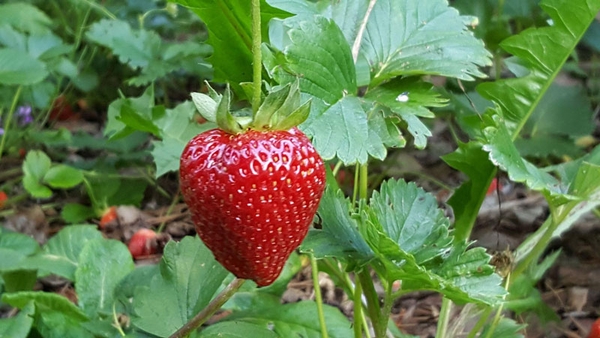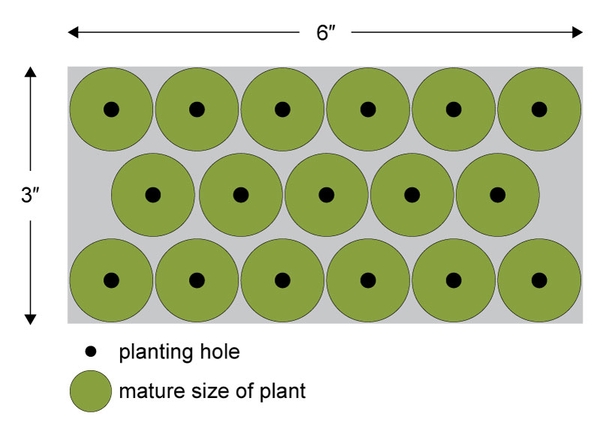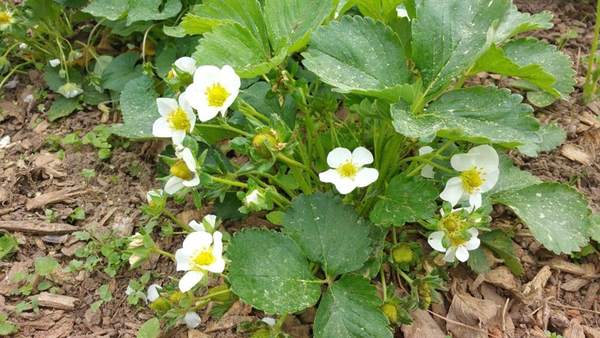Strawberries are the perfect fruit for early childcare centers. Their life cycle is short (planted in September and harvested in April), so children can plant, watch the flowers bloom, observe pollinators in action, watch the fruit develop, and enjoy the delicious, nutritious result of their newly acquired gardening skills. Many children are familiar with strawberries and eager to eat the fruit. Easy to grow, they have very few pests or diseases to challenge inexperienced gardeners.
Cultivate a Garden Team
Include teachers, students, parents, farmers, North Carolina Cooperative Extension personnel, the NC Farm Bureau, and other community groups to make growing strawberries fun, successful, and sustainable. The North Carolina Strawberry Association can connect teachers with farmers and offer possible sources for plants, plastic mulch, and other supplies. Gardens are most successful and sustainable when thoughtfully planned by an engaged team. Determine which classes and teachers will be involved and who will be responsible for regular weeding, watering, and harvesting.
Cultivar Selection
Select a cultivar known to thrive in North Carolina. ‘Chandler’ and ‘Galletta’ varieties do well across the state. Other recommended varieties include ‘Albion’, which grows well in the mountains, and ‘Jewell’, which produces well in both the mountains and the piedmont. Consider planting early-season ‘Galletta’ with mid-season ‘Chandler’ and late-season ‘Jewell’ to extend your harvest. See the Extension Gardener Plant Toolbox for details of these varieties and others.
Plant
Site Selection and Preparation
- Eight hours of sunlight: Avoid sites with tall trees or buildings on the southern side since the low angle of the sun will cast a long shadow during the winter.
- Well-drained soil: Add compost to improve soil drainage or build a raised bed and fill it with a topsoil-compost blend. Some urban soils have chemical contaminants from prior land use. The following links will help you identify and minimize risks: Managing Urban Soils, Minimizing Risks of Soil Contaminants in Urban Gardens (NC State Extension publication AG-439-78), and Check Your Dirt NC!
- Water: Ensure access to potable water to irrigate the strawberry plants. They will need one inch of water each week. If there is less than one inch of rain, make up the difference by watering.
- Soil preparation: NC State Extension Agents and Extension Master Gardener Volunteers can guide you in preparing the soil for planting. Watch this short video, How to Test Your Garden Soil, or review soil testing instructions from Extension Gardening, on how to submit a soil sample for analysis and for recommendations on which nutrients to add. Soil tests are free between April 1 and November 30 and cost $4.00 between December 1 and March 31.
- Optional: Use a very thin, strong, flexible horticulture-grade black plastic to cover the soil. The black plastic warms the soil, acts as a mulch to suppress weeds, conserves water, and limits disease. Available in 5-foot-wide rolls, growers often have leftover lengths they might be willing to provide for minimal or no cost. It might also be obtained through farm supply stores or the NC Strawberry Association.
Timing
- Plant young strawberry plants in the early fall and the fruit will be ready to harvest in April or May.
Spacing
- A 3-by-6-foot bed can contain 17 plants, each of which may provide up to 1.5 pounds of fruit for a total of 25.5 pounds of fruit.
- Include 4-foot-wide pathways around the beds to allow plenty of room to walk and work without stepping on the soil and roots where the strawberries are growing. Consider the number of children who may be working around the beds at one time when determining path width.
- Strawberries also grow well in 1- to 5-gallon containers or even planted directly into 16 to 25 bags of potting soil.
Manage
- Row Covers: Made from non-woven, spunbonded material, row covers can be placed over strawberry plants to protect them from wind and cold while letting in light and rain. Refer to Protecting Garden and Landscape Plants During Cold Weather for details on covers and methods. Place the cover early in the day to trap the sun’s heat. Remove covers on warm days to allow pollinators to visit the flowers and to improve air circulation, which helps minimize diseases. Obtain row covers in weights of 1.0 to 1.5 ounces per square foot through your farmer connection, the NC Strawberry Association, a local farm supply store, or an online garden supply company.
- Pests: There are several effective strategies for managing slugs. Place a slightly propped board in the garden overnight and in the morning dispose of the slugs found on the bottom. Spreading crushed eggshells or hydrated lime around the base of plants will discourage slugs. Experiment with the children and see what works best in your garden. While heavy mulch is good for weed management, it gives slugs a place to hide.
Timeline of Garden Tasks
Times may vary slightly in the coastal plains and mountains.
August
Plan
- Assemble a team and make a plan for who will do what by when.
- Pick a sunny location and test the soil to identify fertilizer and other nutrient needs.
Early September
Prepare the Garden Beds
- Build the beds by loosening the soil and mixing in the amendments recommended on the soil test report, which may include lime, compost, fertilizer, and other soil amendments. Follow the labeled instructions on the fertilizer bag.
- Make beds 3 feet wide, up to 6 feet long, and 6 to 8 inches high. Place beds at least 4 feet apart.
- Put a soaker hose (or drip tubing) down the middle of each bed on the surface of the soil. If the soil is dry, moisten it at least one day before planting.
- Cover the soil with mulch or place black plastic tightly over the bed. The tighter the plastic, the more the soil will warm during the winter, encouraging more root and plant growth. Anchor the plastic by burying the edges, using wire staples, placing rocks or bricks along the edges; or, alternately, roll the excess plastic tightly around poles, pipes, or two-by-fours laid at the edge of the bed.
- Fence the area if necessary to keep out deer, rabbits, and unwanted visitors.
Planting
- In western North Carolina, plant gardens in early September. Gardens in the piedmont to the coastal plain can be planted from mid-September to early October.
- Acquire the strawberry plants from a garden center, nursery, or grower. Plants grown in plug trays are the best. Use only strong, healthy plants. If you are not able to plant immediately, keep the plants in a partially shaded place outside and water frequently.
- Measure and mark planting holes in the plastic.
- The plants should be set in a staggered pattern, approximately 12 inches apart in rows that are 12 inches apart. See the planting diagram below.
An easy way to mark is just to press a dimple into the plastic. Cut a slit or ‘X’ at each mark about 3 inches long or use a bulb planter to make the hole.
Water your plants in the trays thoroughly before planting. Using a bulb planter, narrow trowel, or any flat blade about 2 inches wide, make holes that are about 3 inches deep in the soil below your cuts in the plastic. Press the plants into the holes and pull the soil tight to them. The soil of the plug plants should be slightly below the soil in your strawberry bed. Water immediately after planting through the holes in the plastic, applying 4 to 8 ounces to each plant.
- Keep plants watered daily for the next week. The old leaves will eventually die and new ones will begin to form in about a week to 10 days.
November–February
Establishing Plants
- Check the soil moisture by pushing your finger a few inches into the soil near the base of the plant. Water as needed.
- Cover plants with the row covers anytime weather forecasts predict temperatures below 15°F. Remove covers when temperatures are predicted to stay above 15°F for more than a couple of days.
- Keep the row cover gathered alongside the bed so it can be pulled over the plants as needed.
- In late winter, carefully pinch off and discard the dead leaves. Do not pull up plants or break off crowns.
February–March
Early Plant Growth
- Fertilize weekly mid-March through mid-May by pouring 1 cup of liquid fertilizer through each hole. Use 1 tablespoon per gallon of a 20-20-20 water-soluble fertilizer.
March–April
Beginning to Flower
- Flowers are more tender than leaves. Cover plants anytime the weather forecast calls for temperatures below 32°F. If temperatures are predicted to fall below 25°F, consider applying a second layer of row cover. You can also double-cover plants with clear plastic, old bedspreads, or sheets. Remove covers when the sun hits the plants and the air temperature is above 32°F. Covers other than clear plastic can be left on for several days during a cold snap to hold in heat and reduce labor.
- Water plants as needed through your drip tape or soaker hose. Remember that a sufficient amount of rain cannot get through the plastic, so plants must be watered.
April–June
Ripe Fruit Begins to Form
- Keep plants well watered as the weather gets warmer. The need for water will increase as the plant grows. Do not overwater or let the bed dry out. Probe with a finger to check soil moisture.
- Fruit will begin to ripen! Pick when the berries are red. Remove and dispose of any fruit that is damaged, overripe, or moldy to reduce the spread of disease. Do not compost damaged fruit.
Mid–June
Plant Summer Cover Crop
- Strawberry plants rarely perform well in North Carolina after the first year. At the end of the harvest season, pull up the plants, and if there is no sign of disease, compost them (away from the strawberry bed to minimize disease). If there are signs of disease, discard the plants and do not compost them.
- Gather up black plastic and throw it away. Store row covers and soaker hoses for next year.
- Plant a cover crop to prevent weeds and erosion while adding organic matter and nitrogen to the soil. Crimson clover is beautiful and readily available.
- If you see signs of disease or insect problems, including leaves turning yellow or orange, spots on leaves, or deformed berries, discard the plants after the harvest, and then plant new plants in the fall in a different location or replace the soil in your planter. Every year you reuse the location and soil, you increase your chances of disease.
For information on common strawberry problems and how to manage them, see the Small Fruits Diagnostic Table in the North Carolina Extension Gardener Handbook and the Strawberry Diagnostic Key.
Fun with Strawberries
Books
- Little Mouse, the Red Ripe Strawberry and the Big Hungry Bear by Don and Audrey Wood
- The First Strawberries by Joseph Bruchac
- Strawberry Time, available from the NC Strawberry Association
- First Woman and the Strawberry: A Cherokee Legend by Gloria Dominic
- The Grey Lady and the Strawberry Snatcher by Molly Bang
- Strawberry Picking by June Crebbin
Videos
- "The Little Mouse, the Red Ripe Strawberry & the Big Hungry Bear." Mr. Paulson Reads. August 5, 2022. Video.
- "Strawberry Fruit Rhyme for Children, Strawberry Cartoon Fruits Song for Kids." APPUSERIES. December 20, 2014. Video.
- "Felt Story: Jamberry by Bruce Degen." Jbrary. April 23, 2013. Video.
Activities
- Strawberries ... You Can Count Them! A Lesson Plan for Kindergarteners, NC Farm Bureau (PDF, 477 KB)
Additional Resources
- Troubleshooting Strawberry Problems
- The Natural Learning Initiative
- Strawberries in Schools
- North Carolina Extension Gardener Handbook
- NC State Extension Strawberry Growers Information
- Strawberry Curriculum, NC Farm Bureau
- Garden Help Directory — Contact the local N.C. Cooperative Extension center in your county.
Acknowledgments
Funding for this publication was provided in part by the John Rex Endowment.
The authors would like to thank Melissa Bell, Research Associate, Center for Environmental Farming Systems Field Research, Education and Outreach Liaison, NC State University, for their management of the review process.
This publication was developed in partnership with the Natural Learning Initiative in the College of Design at North Carolina State University.
About the Local Foods Series: Childcare Center Production Gardens
This publication in the Local Foods series is one of 15 publications about childcare center production gardens:
- Growing and Cooking Fruits and Vegetables at Childcare Centers (LF-007-01)
- Creating Childcare Center Production Gardens (LF-007-02)
- Growing Warm-Season Fruits and Vegetables in Childcare Production Gardens (LF-007-03)
- Growing Cool-Season Vegetables in Childcare Production Gardens (LF-007-04)
- Snacking and Cooking with Warm-Season Produce from Childcare Production Gardens (LF-007-05)
- Snacking and Cooking with Cool-Season Produce from Childcare Production Gardens (LF-007-06)
- Composting in Childcare Center Production Gardens (LF-007-07)
- Vermicomposting in the Childcare Center Production Gardens (LF-007-08)
- Introducing Children to Insects in Childcare Center Gardens (LF-007-09)
- Easy Fruits to Grow at Childcare Center Gardens (LF-007-10)
- Growing Strawberries in Childcare Center Gardens (LF-007-11)
- Managing Weeds in Childcare Center Gardens (LF-007-12)
- Growing Fruit Trees in Childcare Center Gardens (LF-007-13)
- Growing Muscadines in Childcare Center Gardens (LF-007-14)
- Growing Blueberries in Childcare Center Gardens (LF-007-15)
Publication date: July 27, 2023
LF-007-11
N.C. Cooperative Extension prohibits discrimination and harassment regardless of age, color, disability, family and marital status, gender identity, national origin, political beliefs, race, religion, sex (including pregnancy), sexual orientation and veteran status.






